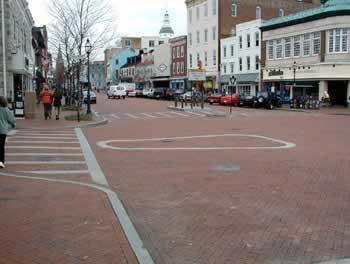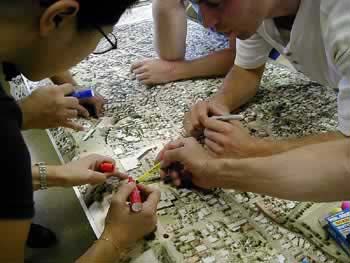|
How Can I Find and Help Build
a Walkable Community - continued
| 9. Town is Thinking Small. The
most walkable towns are boldly stepping forward requiring
maximum parking allowed, versus minimum required. Groceries
and other important stores are not permitted to build
above a reasonable square footage, must place the foot
print of the structure to the street, etc. Palo Alto,
for instance, caps their groceries at 20,000 square
feet. This assures that groceries, drug stores and other
important items are competitive at a size that is neighborhood
friendly. Neighborhood schools are community centers.
Older buildings are rebuilt in place, or converted to
modern needs. Most parking is on-street. |
 |
|
| |
 |
10. In Walkable Communities There Are Many
People Walking. This sounds like a silly statement
at first ... but think again. Often there are places
that look walkable, but no one walks. Why? There is
always a reason. Is it crime? Is it that there is no
place to walk to, even though the streets and walkways
are pleasant? Are the downtown stores not open convenient
hours? You should be able to see a great diversity of
those walking and bicycling. Some will be very young,
some very old. People with disabilities will be common.
Another clue, where people walk in great abundance virtually
all motorists are courteous to pedestrians. It is true. |
|
| |
11. The Town and Neighborhoods have a Vision.
Seattle, Washington, Portland, Oregon and Austin,
Texas are just three examples where neighborhood master
plans have been developed. Honolulu sets aside about
$1M per year of funds to be spent by each neighborhood.
Visionary, master plans provide direction, build ownership
of citizens, engage diverse people, and create opportunities
for implementation, to get past sticky issues, and deal
with the most basic, fundamental, necessary decisions
and commitment. There are budgets set aside for neighborhoods,
for sidewalks, trails, links, parks. The community no
longer talks about where they will get the money, but
how they will change their priorities. |
 |
|
| |
12. Decision Makers Are Visionary, Communicative,
and Forward Thinking. The town has a strong majority
of leaders who "get it". Leaders know that they
are not to do all the work ... but to listen and respond to
the most engaged, involved, broad minded citizens. They rarely
are swayed by the anti-group, they seek the opinions and involvement
big brush citizens and retailers. They are purposefully changing
and building policies, practices, codes and decisions to make
their towns pleasant places for people ... reinvesting in
the town center, disinfesting in sprawl. These people know
the difference between a green field, brown field and grey
field. They know what Active Living by Design is all about.
The regional government understands and supports the building
of a town center, and is not attempting to take funds from
the people at the center to induce or support sprawl. Often
there is a charismatic leader on the town board, chamber of
commerce, planning board, there is an architectural review
team, a historic preservation effort, and overall good public
process. Check out the web site of the town ... if they focus
on their golf courses, tax breaks, great medical services,
scenic majestic mountains, or proximity to the sea ... fail
to emphasize their neighborhood schools, world class library,
lively downtown, focus on citizen participation ... they are
lost, bewitched and bewildered in their own lust and lure
of Walt Disney's Pleasure Island.
|
Previous | 1
| 2 | 3 |
4 | 5 | 6
| Next
|
Walkable
Communities.,
33 E. Pine Street, Orlando, FL 32801 (866) 347-2734
For any comments, questions or suggestions about the content of
this web site please email: Ken Owens
Last Updated:
April 22, 2005
|
|



